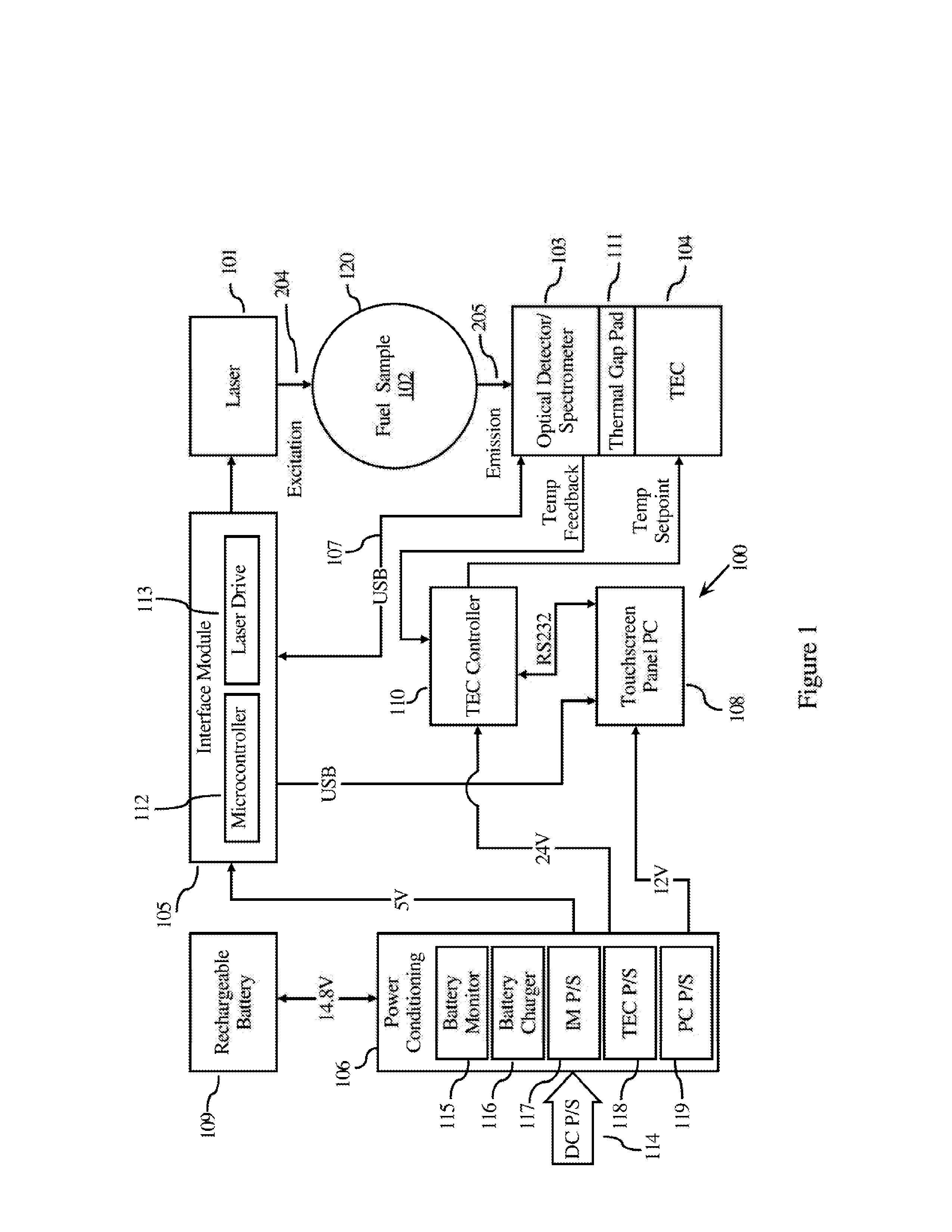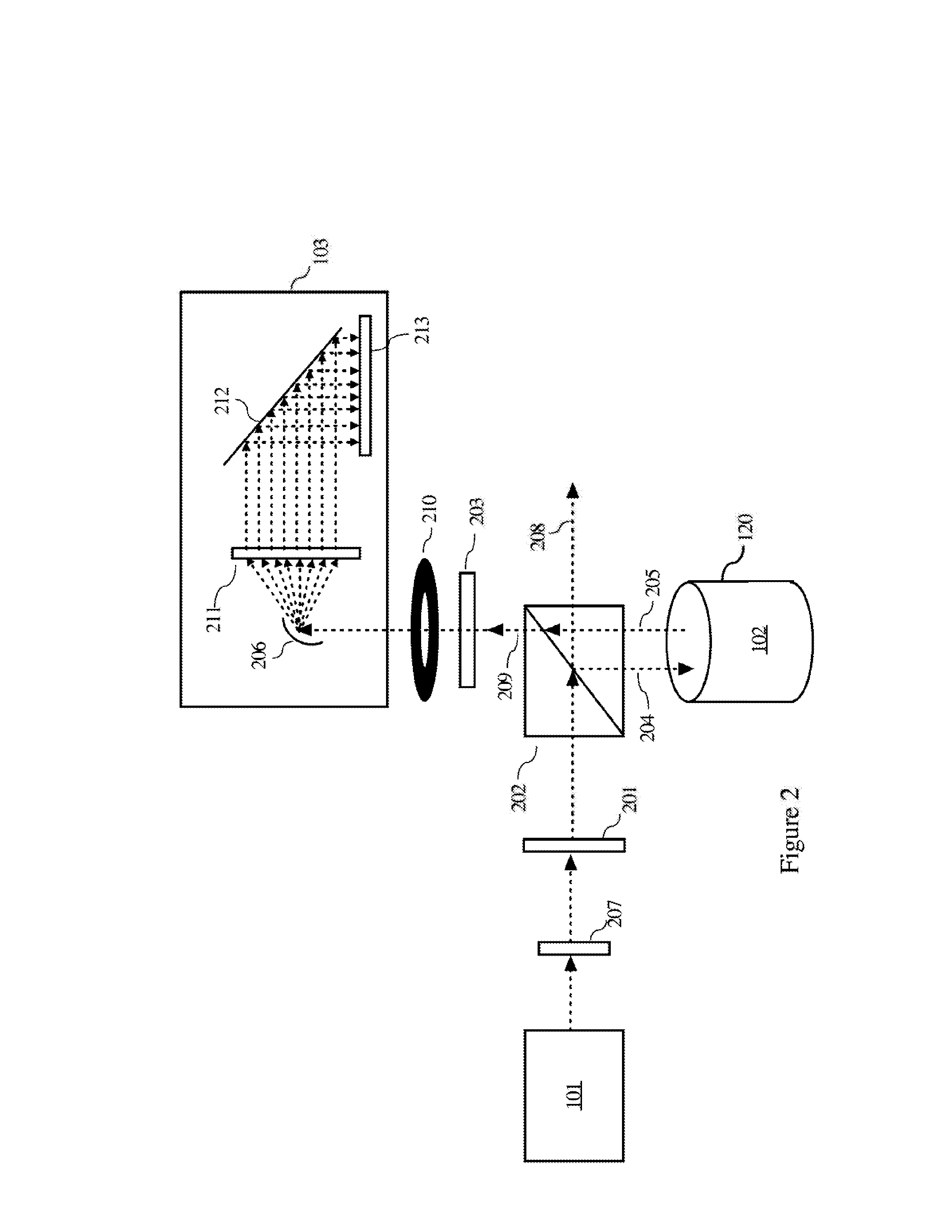Determining the Quantity of a Taggant in a Liquid Sample
a technology of fluorescent taggant and liquid sample, which is applied in the direction of fluorescence/phosphorescence, material analysis through optical means, instruments, etc., can solve the problem of difficult fluorescence-based analysis medium, fuel constituent change, and complicating the quantification of fluorescent taggan
- Summary
- Abstract
- Description
- Claims
- Application Information
AI Technical Summary
Benefits of technology
Problems solved by technology
Method used
Image
Examples
example no.1
Example No. 1
Detection of Kerosene in Diesel Fuel
[0123]Governments of countries often subsidize a fuel product such as kerosene to provide a low cost fuel for economically depressed households for a source of energy for cooking and lighting. However, these programs are often subject to widespread abuse. Subsidized kerosene is sold at much lower prices than gasoline or diesel and is frequently diverted by corrupt groups for use as a transport fuel.
[0124]For this example, a kerosene sample was dosed at 200 parts per billion (ppb) (w / w) with a fluorescent taggant (e.g., NIR Fluorophore: BF2 Chelated [3,5-di-(4-methoxyphenyl)-5-phenyl-1H-pyrrol-2-yl)]-[3-(4-methoxyphenyl)-5-phenylpyrrol-2-ylidene]amine). The marked kerosene was then added into samples of five different diesel fuels of varying origin. The diluted diesel sample was then analyzed by two different methods, first with an instrument disclosed in U.S. Pat. No. 5,525,516 (a filtered photodiode-based fluorescence detector), whic...
example no.2
Example No. 2
Dilution of Premium Branded Gasoline
[0139]For petroleum companies who develop proprietary fuel additive packages, it is important to verify that the fuel additive is present and at the appropriate concentration in the finished gasoline to provide the level of performance promised to a customer. It is not uncommon for independent corrupt station owners to dilute premium branded fuel products with either market generic fuels or other inexpensive industrial solvents. This practice is financially advantageous since market generic fuels and solvents are often cheaper than branded premium fuels.
[0140]For this example, a premium branded gasoline sample was dosed at 30 ppb (w / w) with a florescent taggant (e.g., NIR Fluorophore: 1[4], 8[11], 15[18], 22[25] Tetrakis [[4-[2-ethylhexyloxy]carbonyl]phenoxy]phthalocyanine). The marked gasoline was then diluted with samples of five different fuels of varying origin. The diluted gasoline samples were then analyzed by two different meth...
example no.3
Example No. 3
Multiple Marker Detection
[0149]It is often the case that several brand owners within the same geographic region will want to utilize the same or similar marking technologies. It is anticipated that this will continue to be the case for the present invention. For such circumstance, a brand owner will sometimes use two or more fluorescent taggants (with each fluorescent taggant at its own predetermined concentration) as this will render it unlikely that another brand owner in the same geographical region would use the same combination of taggants (and particularly at such predetermined concentrations).
[0150]However, it is highly likely that the two (or more) fluorescent taggants used will exhibit a degree of spectral overlap because (a) the fluorescence of organic fluorophores encompasses a relatively wide wavelength range (i.e., a width of 50-150 nm) and (b) the practical marking range within the NIR region is relatively small (i.e., wavelength range of 600-1000 nm).
[015...
PUM
| Property | Measurement | Unit |
|---|---|---|
| wavelength range | aaaaa | aaaaa |
| wavelength range | aaaaa | aaaaa |
| wavelengths | aaaaa | aaaaa |
Abstract
Description
Claims
Application Information
 Login to View More
Login to View More - R&D
- Intellectual Property
- Life Sciences
- Materials
- Tech Scout
- Unparalleled Data Quality
- Higher Quality Content
- 60% Fewer Hallucinations
Browse by: Latest US Patents, China's latest patents, Technical Efficacy Thesaurus, Application Domain, Technology Topic, Popular Technical Reports.
© 2025 PatSnap. All rights reserved.Legal|Privacy policy|Modern Slavery Act Transparency Statement|Sitemap|About US| Contact US: help@patsnap.com



